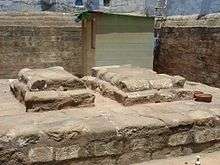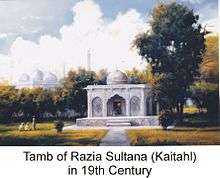Razia Sultana
| Razia Sultan Razia Begum | |
|---|---|
 Grave of Razia Sultan in Bulbul-i-Khan near Turkmen Gate, Delhi | |
| Sultan of Delhi | |
| Reign | 10 November 1236 – 14 October 1240 |
| Coronation | 10 November 1236 |
| Predecessor | Rukn ud din Firuz |
| Successor | Muiz ud din Bahram |
| Born |
1205 Budaun, Uttar Pradesh, India |
| Died |
14 October 1240 (aged 35) Delhi, Delhi Sultanate |
| Burial | Bulbul-i-Khan near Turkmen Gate, Delhi |
| Spouse | Malik Altunia full name Malik Ikhtiaruddin Altunia or known as Mirza Altunia |
| Issue | Zubruddin Mirza Rashil (1237–1238); adopted son |
| Dynasty | Mamluk |
| Father | Iltutmish |
| Mother | Qutub Begum |
Raziya Begum, sultan name, Raziya al-Din (1205 – October 13, 1240), throne name Jalâlat-ud-Dîn Raziyâ, usually referred to in history as Razia Sultan, was the Sultan of Delhi from 10 November 1236 – 14 October 1240. She was famously the only female ever to rule the Delhi Sultanate.[1]
Early life and career
Razia Sultana was the daughter of Shams-ud-din Iltutmish, who had begun life as a Turk slave and ended it as Sultan of Delhi.[2] Iltutmish had been a great favorite of his master, Qutb ud din Aibak, the first Sultan of Delhi, so Aibak had his daughter Qutub Begum married to Iltutmish. Qutub Begum was the mother of Razia, and Razia was thus a maternal granddaughter of Qutb ud din Aibak and Shamshad Begum (Valide Sultan). Razia also had a brother, Nasiruddin Mahmud. Razia, being a member of the ruling family, grew up in privileged circumstances and was close to the levers of power both within the harem (where her mother was dominant) and in the court, where she was a favorite of both her maternal grandfather and her father. This was in contrast with her half-brothers Rukn ud din Firuz and Muiz ud din Bahram, who were the sons of former slave-girls, and thus grew up quite distant from the centers of power.
When Razia was five years old, Qutubuddin Aibak died and was succeeded by Iltutmish. Razia was a favorite of her father, and as a child was allowed to be present around him while he dealt with affairs of state. Later, like some other princesses of the time, she was trained to administer a kingdom if required, in the absence of her father or her husband.[3] Her abilities and diligence, no less than her mother's royal lineage, commended Razia to Iltutmish and made her a confirmed favorite with him. Nevertheless, it was Iltutmish's eldest son Nasiruddin Mahmud (Razia's brother) who was groomed by Iltutmish to succeed him.
However, Nasir ud din Mahmud died suddenly in 1229 CE, and Iltutmish was at a loss as to a successor, because he felt that none of his several surviving sons, born of his other wives, were worthy of the throne.[2] In 1230, he had to leave the capital in order to lead an invasion against Gwalior. During his absence, Razia acted as a competent regent, with the assistance of the Sultan's trusted minister. Iltutmish returned to Delhi in 1231 after having captured Gwalior, and the issue of succession was foremost on his mind. Iltutmish became the first sultan to appoint a woman as his successor when he designated Razia as his heir apparent. Razia was the first and only female ruler of Delhi Sultanate. However, after Iltutmish died on Wednesday 30 April 1236, Razia's half-brother Rukn ud din Firuz was elevated to the throne instead.
Rukn ud din Firuz's reign was short. With Iltutmish's widow Shah Turkaan for all practical purposes running the government, Rukn ud din abandoned himself to the pursuit of personal pleasure and debauchery, to the outrage of the citizenry. On November 9, 1236, both Rukn ud din and his mother Shah Turkaan were assassinated[4] after only six months in power. With reluctance, the nobility agreed to allow Razia to reign as Sultana of Delhi.[5]
Razia was an efficient ruler and possessed all the qualities of a monarch. According to Minhaj-i-Siraj, she was "sagacious, just, beneficent, the patron of the learned, a dispenser of justice, the cherisher of her subjects, and of warlike talent, and endowed with all the admirable attributes and qualifications necessary for a king. She is also famous for her romantic involvement and legends with her lover and later turned husband, Malik Ikhtiar-ud-din Altunia "[6]
Love life and marriage
Razia and Malik Ikhtiar-ud-din Altunia, the governor of Bathinda, were childhood friends. Some recognize them as childhood sweethearts who were strongly in love with each other. However, when Altunia was in Bathinda, the Turkic aristocracy spread rumors about Razia's romantic involvement with Jamal-ud-Din Yaqut, an Abyssinian Siddi (Habshi) slave. This triggered Altunia's jealousy and he led a rebellion against Razia, simply with the intention of getting her back.[7]
A battle between Razia and Altunia ensued in which Yaqut was killed and Razia was taken prisoner.[8] She was incarcerated in April 1240 at Qila Mubarak at Bathinda. While in prison, Razia was allowed to go to Hajirattan mosque to offer prayers on Fridays in a special palki. She was kept in royalty and Altunia visited her regularly. It was then that their love triumphed and finally she was released in August 1240. Razia won over Altunia with love and married him.
Conspiracy for downfall
After Razia ascended to the throne, the Turkic nobles formed a plan of an organized resistance. They wanted to weaken royalty permanently vis-a-vis the nobility. The leader of this conspiracy was Malik Ikhtiar-ud-din Altunia, Razia's lover, who had risen from the office of the governor of Bathinda. Altunia felt that no large-scale rising was possible in Delhi as long as the sultana was present there because of her precautionary measures. The plans were therefore laid out with great care. Altunia first raised the standard of revolt. Razia immediately proceeded against him at the head of an army. Altunia and his fellow-conspirators captured Razia. She was entrusted to the care of Altunia and the rest of the nobles returned to the capital.[9]
Death
Meanwhile, Razia's half-brother, Muiz ud din Bahram, had usurped the throne. Altunia and Razia undertook a military campaign to take back the sultanate from Bahram, but they were defeated on the 24th of Rabi' al-awwal 638 A.H. (October 1240). They fled Delhi and reached Kaithal the next day, where their remaining forces abandoned them. They both fell into the hands of Hindu Jats and were robbed and killed on the 25th of Rabi' al-awwal 638 A.H.,[10] this date corresponds to October 13, 1240.[11] Bahram, for his part, reigned from 1240 to 1242, but would be dethroned for incompetence.
The place of Razia's burial is disputed by historians. There are 3 places where Razia is claimed to be buried. They are Delhi, Kaithal and Tonk, Rajasthan.[12]Some people also say that she was buried where she died in the hands of the Jats.
Legacy
Razia was reportedly devoted to the cause of her empire and to her subjects. There is no record that she made any attempt to remain aloof from her subjects, rather it appears she preferred to mingle among them. She especially protected and preserved the indigenous cultures of her Hindu subjects during her reign.[13]
Razia established schools, academies, centers for research, and public libraries that included the works of ancient Hindu philosophers along with the Qur'an and the traditions of Muhammad.. Her reign was characterised as spirited and dynamic by many.
In popular culture
Razia Sultan is a 1983 biopic on Razia Sultan, with Hema Malini taking the titular role.[14]
In 2015, & TV started airing a TV series on the life of Razia Sultan, starring Pankhuri Awasthy which highlighted her tough journey towards becoming a Sultana and her much spoken about passionate love life with Altunia.[15]
Claimed burial sites
There are conflicting accounts regarding her actual site of grave. No archaeological or documentary evidences are found to confirm the site of her grave. The dispute is whether she was buried in Kaithal[16] or Delhi or Tonk, and also where were Altunia and Yakut buried.
First claim is that Razia's grave lies among the narrow lanes of Old Delhi that is in a courtyard in Bulbul-i-khana, Shahjahanabad, near the Turkman Gate entrance.
There is a tradition that Razia Sultana was buried in Kaithal.[17] Altunia was also buried next to her.There was also a masjid nearby.
Viceroy of India (Lord Linlithgow) in 1938 came to kaithal to visit Razia's tomb. He approved a special grant for the restoration of the tomb.[18] After that Director General Archaeology India visited the tomb but due to second world war, the grant could not be spent on the restoration.
 Grave of Razia Sultan in Bulbul-i-Khan near Turkoman Gate, Delhi
Grave of Razia Sultan in Bulbul-i-Khan near Turkoman Gate, Delhi- Tomb of Razia Sultan in Mohalla Bulbuli Khana
 Painting depicting tomb of Razia Sultana in Kaithal during 19th century
Painting depicting tomb of Razia Sultana in Kaithal during 19th century
References
- ↑ Table of Delhi Kings: Muazzi Slave King The Imperial Gazetteer of India, 1909, v. 2, p. 368..
- 1 2 Reina Pennington (2003). Amazons to Fighter Pilots: a Biographical Dictionary of Military Women. Westport, CT: Greenwood press. p. 355. ISBN 0313291977.
- ↑ Gloria Steinem (Introduction), Herstory: Women Who Changed the World, eds. Deborah G. Ohrn and Ruth Ashby, Viking, (1995) p. 34-36. ISBN 978-0670854349 Archived June 19, 2006, at the Wayback Machine.
- ↑ Satish Chandra, History of Medieval India(800–1700), New Delhi, Orient Longman, (2007), p.100. ISBN 81-250-3226-6
- ↑ Reina Pennington (2003). Amazons to Fighter Pilots: a Biographical Dictionary of Military Women. Westport, CT: Greenwood press. p. 356. ISBN 0313291977.
- ↑ Sen, Sailendra (2013). A Textbook of Medieval Indian History. Primus Books. pp. 74–76. ISBN 978-9-38060-734-4.
- ↑ Richard Pankhurst (21 May 1999) "Ethiopia Across the Red Sea and Indian Ocean", Addis Ababa, Addis Tribune.
- ↑ "Raziya Sultan". indiasite.com.
- ↑ Sanjay Tripathi History of Medieval India
- ↑ Razia Sultan The History of India, as Told by Its Own Historians. The Muhammadan Period, 1867–1877.
- ↑ Conversion of Islamic and Christian dates
- ↑ Verde, Tom. 2016. Malika II: Radiyya bint Iltutmish. AramcoWorld. Volume 67 (3). May/June 2016. Pages 34–37.
- ↑ Majumdar, R.C., ed. The History and Culture of the Indian People. Volume V. Bombay: Bharatiya Vidya Bhavan, 1957
- ↑ "Razia Sultan". Internet Movie Database. Retrieved 5 March 2015.
- ↑ "Pankhuri Awasthi follows Hema Malini for 'Razia Sultan'". Times of India. IANS. 5 February 2015. Retrieved 5 March 2015.
- ↑ http://kaithal.nic.in/history.htm
- ↑ 1- Book Name "Taareekh-e-Punjab by Kalidas Rai, 2- "Taareekh Buzargaan-e-Kaithal by Sheikh Muhammad Shakir Shah Abadi
- ↑ Book Name "Ehad-e-Gul by Syed Fayyaz Hussain Zaidi
| Preceded by Rukn ud din Firuz |
Mamluk Dynasty 1236–1240 |
Succeeded by Muiz ud din Bahram |
| Preceded by Rukn ud din Firuz |
Sultan of Delhi 1236–1240 |
Succeeded by Muiz ud din Bahram |
Bibliography
- Asif, Salman, and Kate Montgomery. Razia: Warrior Queen of India. London: Hood Hood Books, 1998. http://www.worldcat.org/oclc/43208215
- Goel, Devendra, Chandrakant Chadda, Nirupa Roy, Jairaj, Kamran, M. Kumar, N.A. Ansari, and Lachhiram. Razia sultan Raziyā Sultāna. Mumbai: Shemaroo Entertainemtn, 2012. DVD; NTSC all regions; 5.1 surround sound. Hindi with English subtitles. Abstract: A tale of stormy love and passion for each other and unflinching loyalty between Razia, the Queen Empress of India and an Abyssinian slave Yaqub. She became immortalised as a symbol of the highest, the noblest and the most sacred in love. http://www.worldcat.org/oclc/905056178
- Dasgupta, Shahana. Razia: The People's Queen. New Delhi: Rupa & Co, 2001. http://www.worldcat.org/oclc/422540172
- Maqbul Arshad. Razia Sultana. Lahore: Maqbul Academy, 1900. Fiction: Juvenile audience: Urdu. http://www.worldcat.org/oclc/651942430
- Waeerkar, Ram, and Anant Pai. Sultana Razia: Empress of India. Mumbai: Amar Chitra Katha, ACK Media, 2009. http://www.worldcat.org/oclc/609715545
- Zakaria, Rafiq. Razia, Queen of India. [Bombay]: Popular Prakashan, 1966. http://www.worldcat.org/oclc/1210383